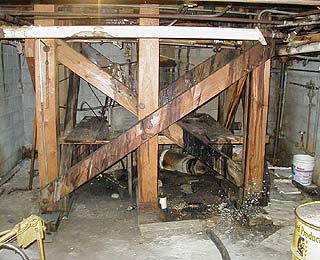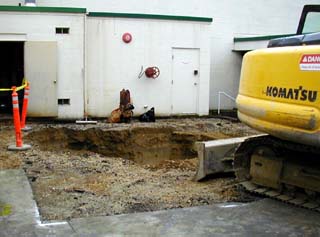
Surveys
DJC.COM
July 29, 2004
Don't let your site be taken to the cleaners
Farallon Consulting

McManus
|
Consultants are frequently called upon to assess contamination that remained undiscovered until a pending property sale. Typical of the problems we confront is contamination caused by solvent spills associated with dry cleaning facilities.
How bad can it be?
The cleanup of an average dry cleaning facility can easily cost between $150,000 and $750,000 in consulting, legal, and soil and groundwater cleanup expenses. Some or all of this expense may be covered by insurance. However, most general liability policies began carrying environmental risk exclusions in the mid-1980s. Standard policies written after that time do not cover environmental contamination losses.

Photos courtesy of Farallon Consulting
Small leaks from a dry cleaning machine on the floor above contaminated this building’s basement.
|
The majority of dry cleaning operations use perchloroethylene (PCE) as a cleaning solvent. PCE is used in dry cleaning machines in much the same way that water is used in a home washing machine. The primary difference is that PCE is not discharged to the sewer at the end of each wash cycle. Contemporary dry cleaning machines filter, extract and recycle the cleaning solvent from load to load.
PCE is a chlorinated volatile organic compound classified by the U.S. Environmental Protection Agency as a probable human carcinogen. The maximum contaminant level in groundwater established by EPA is a mere 5 parts per billion. So it doesn't take much of a spill to contaminate an enormous quantity of groundwater. A drip of PCE from a dry cleaning machine every 10 seconds for one week is enough to contaminate 100 million gallons of groundwater to twice the maximum contaminant level.
Add to that startling statistic the results of a recent study by the State Coalition for Remediation of Dry Cleaners, which estimated that 75 percent of all active dry cleaning facilities are contaminated.
Dry cleaning facilities are not the only businesses that use toxic solvents in their operations. Auto repair and body shops, printing and publishing firms, electronics manufacturers, furniture strippers, boat dealerships, machine shops, and many other businesses use solvents in their day-to-day operations.
What's a property owner to do?
Many Farallon clients find themselves in the position of having to clean up a property contaminated by historic business operations that released solvents to the subsurface. These contamination problems are often undiscovered until the owner tries to sell or redevelop the property. The fortunate ones have retained copies of insurance policies dating back to when their properties were first occupied. In other instances, there is no insurance coverage.
What should a property owner who leases to businesses that use solvents do?

A small quantity of cleaning solvent spilled near a dry cleaner’s service entrance resulted in the excavation of a portion of this shopping center parking lot.
|
RULE 1 — Keep good records
In many cases, a property owner's older general liability insurance policy will cover consulting, legal and cleanup costs. But policies written since the mid-1980s have excluded this type of environmental liability from coverage, unless specific environmental risk riders were attached to the policy.
In cases where there is no insurance, the property owner is left to pursue former tenants that may have caused the contamination, or faces out-of-pocket cleanup costs or the prospect of selling the property at a greatly depreciated price.
RULE 2 — Carry insurance
Make sure that the property is adequately insured against environmental liabilities. If you are leasing property to a business that uses solvents in its day-to-day operations, it is prudent to verify that your tenant carries appropriate insurance coverage for the environmental liabilities associated with its business operations.
RULE 3 — Be proactive
Spills generally will not clean up by themselves. The problems associated with solvent spills only increase over time. Soil contamination can lead to groundwater contamination, which greatly increases the cost and complexity of a cleanup action.
Groundwater contamination can move off your property. As time goes on, cleanup may include neighboring properties in addition to your own. It is usually less expensive to identify a problem and initiate cleanup sooner rather than later, after solvents have dispersed. If you suspect that you may have a problem, it is advisable to have it investigated as soon as possible.
RULE 4 — Monitor tenants
Drop in on your tenants and keep an eye on the way solvents are handled and stored on your property.
There are other monitoring options in addition to periodic impromptu visits to your solvent-using tenant. Farallon has developed a volatile organic compound (VOC) monitoring system that facilitates the sampling of soil vapor from beneath facilities where solvents are used or stored.
A solvent spill that gets beneath a building will result in vapor contamination in the pore space of subsurface soils. Farallon has designed a probe for installation in a building floor slab to enable easy periodic sampling and testing of air beneath the building for the presence of solvent vapors. Annual or semi-annual sampling ensures that solvents have not been released to the soil beneath the floor slab, or that a release is identified and can be addressed promptly before the problem spreads.
The Farallon VOC monitoring system is an inexpensive way to monitor tenant operations and to identify spills soon after they occur. A solvent spill that is discovered early (within months of occurring) is far less expensive to clean up than a spill that occurred years ago and has migrated to groundwater and possibly off your property.
The data generated by the VOC monitoring system documents the timing of and responsibility for any spill, for use in filing insurance claims. Employing the VOC monitoring system also puts business operators on notice that spills will be detected, and that it is in their interest to use best management practices when using solvents.
You can minimize the risk associated with leasing your property to tenants that use solvents by retaining your records, carrying adequate insurance, requiring solvent-using tenants to carry insurance coverage for environmental risks, monitoring tenant operations and being proactive.
Richard W. McManus, P.E., is principal engineer at Farallon Consulting.
Other Stories:
- Conditional closures — another cleanup remedy
- Washington tests watershed management
- Todd Pacific halts a dirty waterfront legacy
- Going green? Try calling on your contractor
- Emerald City must fight to stay green
- Seattle prepares to ‘re-green' 2,500 acres
- Washington's new paint law gets the lead out
- Putting a price tag on nature
- South Lake Union: a model for sustainability
- Guy Battle: design and build to suit your climate
- Contractor finds silver at new headquarters
- Government finds gold at Sea-Tac Airport
- 2004: A great year for the local environment
- Getting to compliance with a systems approach
- Salmon get a boost from technology
- Low-impact development comes to Pierce County
- Energy Star label now ready for homes
- Improving traffic flow for fish, people
- Troubling times for Hood Canal's waters
- Quick Duwamish cleanup begins with teamwork
- Utilities to study energy coming into homes
Copyright ©2009 Seattle Daily Journal and DJC.COM.
Comments? Questions? Contact us.